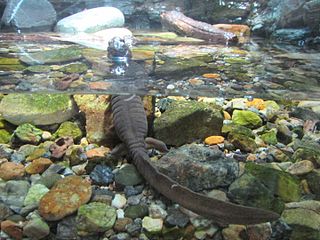
Hynobius yangi, the Kori salamander, is a species of salamander endemic to southeastern South Korea. It is a lentic-breeding species similar to the Korean salamander but is distinguished by factors including tail shape and dorsal coloration. The species is known from the vicinity of the type locality in Gijang County in northeastern Busan and from the nearby Ulju County in western Ulsan.

The Abe's salamander is a species of salamander in the family Hynobiidae. It is endemic to Japan and known from southwestern Honshu in northern parts of the Fukui, Kyoto, and Hyōgo Prefectures. The specific name abei honours professor Yoshio Abe, a Japanese zoologist.

Hynobius is a genus of salamander in the family Hynobiidae, occurring in Japan, Korea, China, Taiwan and Far East Russia.

The Odaigahara salamander is a species of salamander in the family Hynobiidae. It is endemic to Japan. Its natural habitats are temperate forests, rivers, and freshwater springs. This species is threatened by habitat loss.
The Chinese salamander is a species of salamander in the family Hynobiidae endemic to China. Its natural habitats are subtropical or tropical moist lowland forests, rivers, freshwater marshes, freshwater springs, and arable land. It is threatened by habitat loss.

The Oita salamander is a species of salamander in the family Hynobiidae endemic to Japan. Named after Oita Prefecture, its natural habitats are temperate forests, rivers, intermittent rivers, freshwater marshes, intermittent freshwater marshes, and irrigated land in western Japan. It is threatened by habitat loss, due to the increasing construction of homes within its habitat. The Oita Salamander is considered to be vulnerable by the (IUCN) Red List of Threatened Species with a declining population.

Hynobius formosanus, the Taiwan salamander, is a species of salamander in the family Hynobiidae, endemic to Taiwan, where it occurs in the high mountains at around 2,100 m (6,900 ft). Its natural habitats are from open alpine habitats to shaded moist evergreen forests. Adults have a total length of 58–98 mm (2.3–3.9 in).
Hynobius guabangshanensis is a species of salamander in the family Hynobiidae, endemic to China, as it is only known from the locality from where it was described as a new species to science in 2004, at Guabang Shan Tree Farm in Qiyang County of Hunan Province. Its natural habitats are temperate shrubland, swamps, freshwater marshes, and seasonally flooded agricultural land.
The Hakuba salamander or Japanese mountain salamander is a species of salamander in the family Hynobiidae. This salamander is also synonymous with the mountain salamander. It is endemic to Japan. Its natural habitats are temperate forests, rivers, swamps, freshwater springs, and plantations. It is threatened by habitat loss.
Hynobius katoi is a species of salamander in the family Hynobiidae, endemic to Japan. Its natural habitats are temperate forests and rivers.

The Tohoku salamander is a species of salamander in the family Hynobiidae, endemic to Japan. Its natural habitats are temperate forests and rivers.

Hynobius nebulosus, the Mitsjama salamander, is a species of salamander in the family Hynobiidae endemic to Japan. Its natural habitats are temperate forests, rivers, swamps, freshwater springs, and irrigated land. It is threatened by habitat loss.

The Japanese black salamander is a species of salamander in the family Hynobiidae, endemic to Japan.
The Oki salamander is a species of salamander in the family Hynobiidae, endemic to Japan. Its natural habitats are temperate forests, rivers, and plantations. It is threatened by habitat loss.

The Ezo salamander or Hokkaido salamander is a species of salamander in the family Hynobiidae, endemic to Japan. Its natural habitats are temperate forests, temperate shrubland, swamps, freshwater marshes, intermittent freshwater marshes, freshwater springs, irrigated land, and canals and ditches.
Hynobius sonani, the Taichu salamander, is a species of salamander in the family Hynobiidae, endemic to Taiwan, where it occurs in the Central Mountain Range above 2,750 m (9,020 ft). Its natural habitats are from open alpine habitats to shaded moist evergreen forests; it breeds in streams.
The amber salamander, amber-colored salamander, tortoiseshell salamander, or Stejneger's oriental salamander is a species of salamander in the family Hynobiidae, endemic to Japan. Its natural habitats are temperate forests and rivers. It is threatened by habitat loss.
The Hokuriku salamander is a species of salamander in the family Hynobiidae, endemic to Japan. Its natural habitats are temperate forests, rivers, freshwater marshes, freshwater springs, and irrigated land. It is threatened by habitat loss.

The Tokyo salamander is a species of salamander in the family Hynobiidae, endemic to Japan. Its natural habitats are temperate forests, freshwater springs, arable land, irrigated land, and canals and ditches. It is threatened by habitat loss. Many different species of amphibian have unbalanced sex ratios. This trend is no different in Hynobius Tokyoensis; the sex ratio between males and females is about 1.5:1. Although this does not play as large of a role as habitat destruction when it comes to the decline of this species, it is still significant.
Hynobius yiwuensis, the Yiwu salamander, is a species of salamander in the family Hynobiidae, endemic to Zhejiang, China. Its distribution area is central and eastern Zhejiang, and includes Yiwu that has given it its name. Its natural habitats are subtropical moist lowland forests, rivers, freshwater marshes, intermittent freshwater marshes, arable land, and rural gardens. The Yiwu salamander is threatened by habitat loss.











